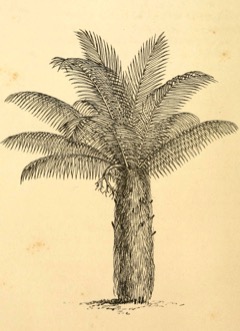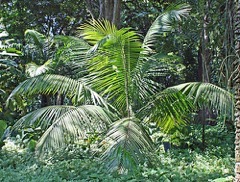 |
|
http://www.edibleplants.org |
 |
| www.palmnutpages.com |
Translate this page:
Summary
Piassaba, Leopoldinia piassaba, is a palm native to Brazil and Venezuela that grows about 4 or 5 m tall with a trunk diameter of 15 cm. Its crown is composed of 14 - 16 sword-shaped, yellow green leaves with each leaf measuring about 4-5 m long. The fruits are kidney shaped and flattened. The mesocarp of the fruits is eaten raw or made into a refreshing beverage. Piassaba is highly valued for its high quality and water resistant fibre which can be obtained from the leaf sheath. It is used to make ropes, brushes, brooms, and baskets among others.
Physical Characteristics

 Leopoldinia piassaba is an evergreen Tree growing to 10 m (32ft) by 8 m (26ft) at a fast rate.
Leopoldinia piassaba is an evergreen Tree growing to 10 m (32ft) by 8 m (26ft) at a fast rate.
See above for USDA hardiness. It is hardy to UK zone 10.
Suitable for: light (sandy), medium (loamy) and heavy (clay) soils. Suitable pH: mildly acid and neutral soils. It cannot grow in the shade. It prefers moist or wet soil.
UK Hardiness Map
US Hardiness Map
Synonyms
No synonyms are recorded for this name.
Plant Habitats
Edible Uses
Edible Parts: Fruit
Edible Uses: Drink
The mesocarp of the fruits is eaten raw or made into a refreshing beverage[317 , 424 ]. The thin flesh of the fruit, agitated with water, makes a popular local drink.
References More on Edible Uses
Medicinal Uses
Plants For A Future can not take any responsibility for any adverse effects from the use of plants. Always seek advice from a professional before using a plant medicinally.
None known
References More on Medicinal Uses
The Bookshop: Edible Plant Books
Our Latest books on Perennial Plants For Food Forests and Permaculture Gardens in paperback or digital formats.

Edible Tropical Plants
Food Forest Plants for Hotter Conditions: 250+ Plants For Tropical Food Forests & Permaculture Gardens.
More

Edible Temperate Plants
Plants for Your Food Forest: 500 Plants for Temperate Food Forests & Permaculture Gardens.
More

More Books
PFAF have eight books available in paperback and digital formats. Browse the shop for more information.
Shop Now
Other Uses
Basketry Broom Fibre Polish String Thatching
Other Uses A fibre is obtained from the leaf sheath[46 , 317 ]. Known as 'piassaba fibre', it is used for making heavy ropes, where it can take the place of manila hemp (Musa textilis)[46 ]. The fibre is also used for making brushes, brooms and baskets[46 , 424 ]. The fibres resist rotting, even after long periods of immersion in water; the Brazilians used them to make cables to navigate the Amazon[424 ]. They are also used for making rope, brooms, brushes and baskets. The foliar sheaths terminate in long (0.5 - 1.5 metres), pendulous fibres. The fibres at first appear as light brown ribbon-like strips, 2 - I0cm wide, that later split into dark brown to greyish brown individual fibres. These fibres persist and hang, entirely concealing the stem, and giving the tree a most curious and unique appearance[424 ]. The leaves are used for thatch[317 ]. The leaves resist rotting, even after long periods of being wet, and make a very resistant thatch[424 ]. They are, therefore, the most sought after of the local palms[424 ]. The nuts, which are a source of vegetable ivory, are encased in a hard, botryoidal shell which itself takes a nice polish. These shells are mostly 3 - 4cm in diameter and are 5 - 8cm long. The nuts are smaller and are loose in the shells. They have a fine delicate dark veining and are quite beautiful when turned or polished.
Special Uses
Carbon Farming
References More on Other Uses
Cultivation details
Industrial Crop: Fiber Management: Standard Regional Crop Staple Crop: Oil
Not known
Carbon Farming
-
Industrial Crop: Fiber
Clothing, rugs, sheets, blankets etc. Currently, almost none of our fiber are produced from perennial crops but could be!
-
Management: Standard
Plants grow to their standard height. Harvest fruit, seeds, or other products. Non-Destructive management systems.
-
Regional Crop
These crops have been domesticated and cultivated regionally but have not been adopted elsewhere and are typically not traded globally, Examples in this broad category include perennial cottons and many nuts and staple fruits.
-
Staple Crop: Oil
(0-15 percent protein, 16+ percent oil). Some of these are consumed whole while others are exclusively pressed for oil. Annuals include canola, poppyseed, maize, cottonseed, sunflower, peanut. Perennials include high-oil fruits, seeds, and nuts, such as olive, coconut, avocado, oil palm, shea, pecan, and macadamia. Some perennial oil crops are consumed whole as fruits and nuts, while others are exclusively pressed for oil (and some are used fresh and for oil).
References Carbon Farming Information and Carbon Sequestration Information
Temperature Converter
Type a value in the Celsius field to convert the value to Fahrenheit:
Fahrenheit:
The PFAF Bookshop
Plants For A Future have a number of books available in paperback and digital form. Book titles include Edible Plants, Edible Perennials, Edible Trees,Edible Shrubs, Woodland Gardening, and Temperate Food Forest Plants. Our new book is Food Forest Plants For Hotter Conditions (Tropical and Sub-Tropical).
Shop Now
Plant Propagation
Seed -
Other Names
If available other names are mentioned here
Piassaba, Piassabam Chiquechique, Chiquichiqui, Fibra, Piassabam Chiquechique, Chiquichiqui, Fibra,
Native Range
SOUTHERN AMERICA: Venezuela (Amazonas), Brazil (Amazonas), Colombia (Guainía)
Weed Potential
Right plant wrong place. We are currently updating this section.
Please note that a plant may be invasive in one area but may not in your area so it's worth checking.
Conservation Status
IUCN Red List of Threatened Plants Status : This taxon has not yet been assessed

Growth: S = slow M = medium F = fast. Soil: L = light (sandy) M = medium H = heavy (clay). pH: A = acid N = neutral B = basic (alkaline). Shade: F = full shade S = semi-shade N = no shade. Moisture: D = dry M = Moist We = wet Wa = water.
Now available:
Food Forest Plants for Mediterranean Conditions
350+ Perennial Plants For Mediterranean and Drier Food Forests and Permaculture Gardens.
[Paperback and eBook]
This is the third in Plants For A Future's series of plant guides for food forests tailored to
specific climate zones. Following volumes on temperate and tropical ecosystems, this book focuses
on species suited to Mediterranean conditions—regions with hot, dry summers and cool, wet winters,
often facing the added challenge of climate change.
Read More
Expert comment
Author
Wallace
Botanical References
Links / References
For a list of references used on this page please go here
A special thanks to Ken Fern for some of the information used on this page.
Readers comment
| Add a comment |
|
If you have important information about this plant that may help other users please add a comment or link below. Only comments or links that are felt to be directly relevant to a plant will be included. If you think a comment/link or information contained on this page is inaccurate or misleading we would welcome your feedback at [email protected]. If you have questions about a plant please use the Forum on this website as we do not have the resources to answer questions ourselves.
* Please note: the comments by website users are not necessarily those held by PFAF and may give misleading or inaccurate information.
To leave a comment please Register or login here All comments need to be approved so will not appear immediately.
|
Subject : Leopoldinia piassaba
|
|
|
|